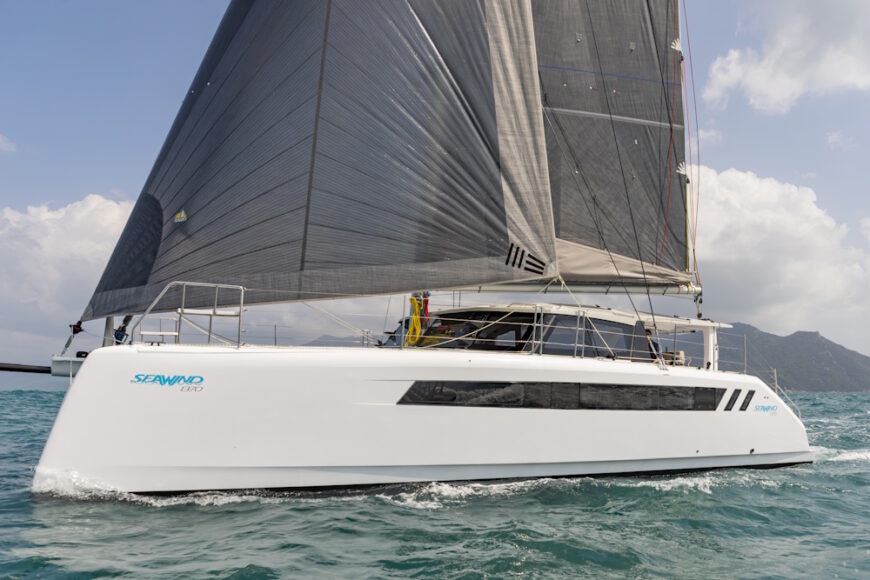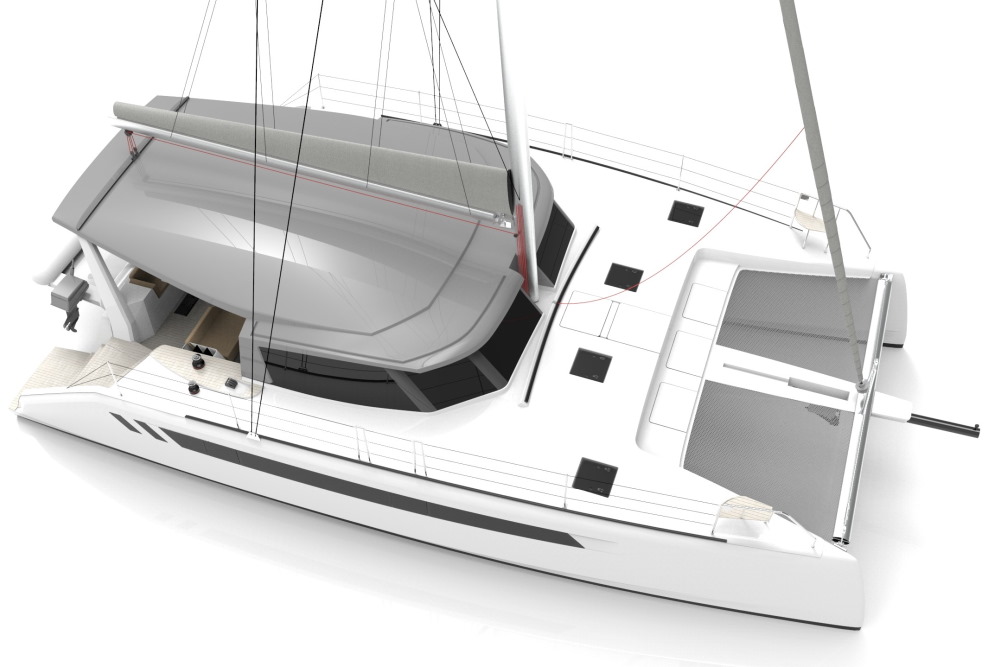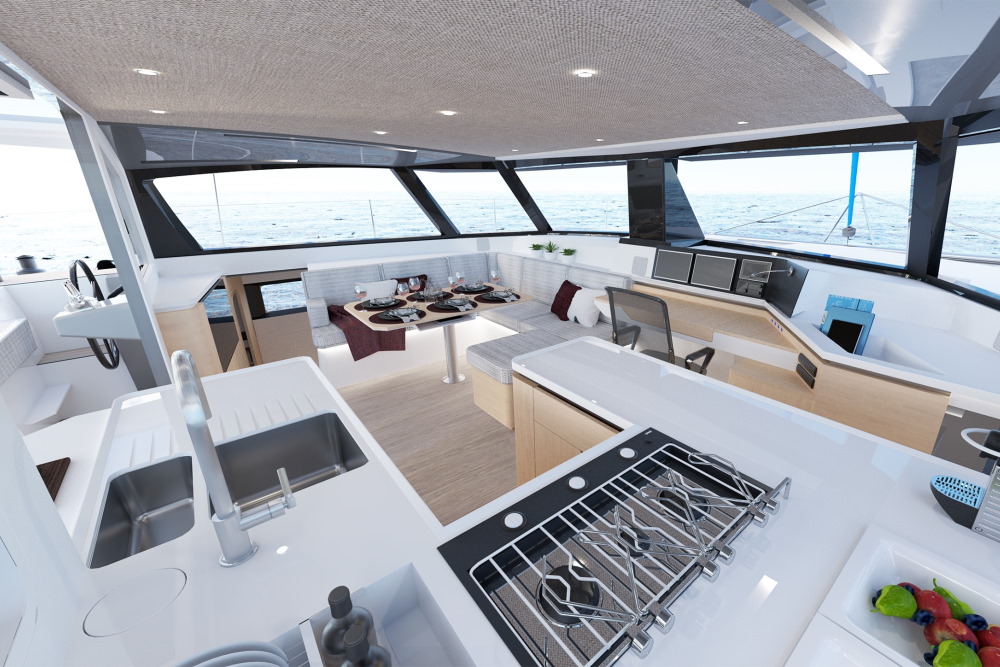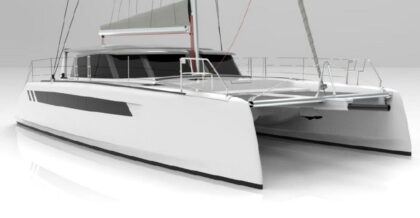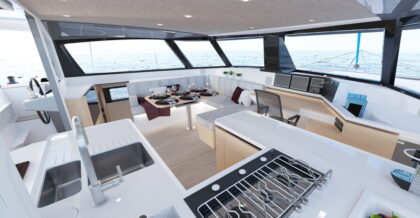Seawind 1370
The Seawind 1370, a 45 footer, builds on the success of the 42 foot Seawind 1260.
Designed by François PERUS and Romain SCOLARI of the Yacht Design Collective (who are the team behind the ITA 14.99), it’s a fine looking boat with sleek boxy lines and reverse bows, influenced by the Seawind 1600 which has a more refined look than its predecessors. With that longeron, she is starting to look like a Gunboat. This yacht will be competing with the likes of the Catana Ocean Class (which probably sits between this boat and the Seawind 1600)
Read more…
It’s a Seller
The new model was designed from the ground up, and has had a very successful launch. Seawind have filled up their order book for the next 5 years. The Australian manufacturer has built over 700 boats in the 35-42ft range, and this is their first “mid-range” cat.
The Seawind 1370 has gone for a galley-up design like the 1600, with an Open design with saloon, galley, cockpit and helms all on one level. They have opted for the usual Seawind mix of performance and comfort that is comparable to a Nautitech. It’s more of a fast cruising cat than a performance cat. Even so, this is built with a completely different philosophy to something like the Bali Catspace which is targeted squarely at the charter market. The 1370 is targeted at owners setting off on long passages.
The boat weighs in at 12 tonnes–very light for a 45-footer, and she will soak up weight well for longer passages.
She is available in 4 configurations: 3 cabins/2 heads, 3 cabins/3 heads, 4 cabins/2 heads and 4 cabins/4 heads.
Pros
- Light and nippy (12 tonnes light)
- Constructed using Closed Cell PVC Foam (no balsa)
- Good load carrying capability
- Points well upwind for a keel cat
- Fully protected helms
- Sheets, reefs and halyards lead aft to winches at the helms
- A low boom that hugs the coachroof: it’s easy to access the mainsail, and this keeps the centre of effort low making a for seaworthy boat in a blow.
- Open plan living maximises the living space.
- Great ventilation at anchor with 2 forward windows that open right up.
- Forward facing nav station
- Lots of solar power negating the need for a generator
- Good value. Seawinds are built in Vietnam.
Cons
- Visibility from the helm. Seawind have worked hard on this with sliding windows in front of the helm and clean sight lines, but the bottom line is that you helm from inside. That’s your compromise for all that protection from the elements. There are clear panes above the helms to check the sails and you can perch on the deck beside the helm but it is more enclosed than the 1260 and 1600 which has more “half in, half out” helms.
- You can’t see the mainsail from the saloon (that said, it’s a quick trip to the helm where there is an overhead window).
- In marinas, you are going to be running between those helms to check your distances. Whatever anyone says, you won’t trust your judgement looking through glass. Docking is easy reversing in though, or coming alongside.
- The outside dining area is pretty small for a 45 footer.
Seawinds are known for their sailing ability and the 1370 doesn’t disappoint on that front. She comes with an 80 sqm square top mainsail and a 36 sqm self tacker. They have moved the mast back on this design versus previous models which gives you a more powerful jib and a nicely balanced sail set up (which is an old Prout trick by the way). There is a reacher on a furler for lighter wind conditions and you can run an asymmetrical spinnaker off the carbon bowsprit at the bow.
The 1370 has fixed keels so she won’t point as high as a daggerboard cat like the Balance 482 but she’s no slouch upwind, particularly when the wind freshens up.
Balanced Sail Plan
The larger jib is somewhere between a traditional self tacking solent and a manual tacking genoa which will help in lighter winds without having to fly sails off the bowsprit. At 12 tonnes lightship, she should get going quickly.

The boom on the Seawind 1370 is low which lowers the centre of effort of the mainsail: all helping her seaworthiness and it also helps to improve the ride. The hull shape has been designed to reduce pitching and give you a smoother motion through the waves.
The hulls are chimed (a design feature perfected by Catana and something that has evolved from the 1600) to give you more living space, particularly in the aft cabin. The hulls are still slender and that means they will still slip through the water nicely.
Bridgedeck clearance is a decent 0.85m with a little wave breaker to help disperse wave energy in a seaway. The weight distribution (fuel, water etc) has been kept low, following the Seawind design DNA.
Fully Protected Helms….the Seawind Way
The helm position is typically Seawind: fully protected with views forward through the saloon. All working lines lead back to the helm with 2 winches and clutches at each helm station. If you want even further protection, you can head to the forward facing nav station in the saloon. With covers and clears up, you can extend your protected area all of the way back.
Clear panels above the helms give you a view of your sails from the helm seat and if you want to go for more sailing feel, you can perch on the side of the deck and helm from there. It is noticeable that the design is more enclosed than the 1600 or even the 1260 which has more “half in, half out” double helms.
Options for your sail locker include a screecher, flown off the end of the longeron, gennaker and a spinnaker,
The 1370 is constructed using PVC closed cell foam: no balsa is used unlike some of the more popular French production catamarans. The hulls are reinforced with a combination of E-Glass and carbon fibre and the bow area has a skin of kevlar to protect against impact. This catamaran has been designed to be a tough boat for world cruising.
The saloon and aft cockpit are on one level and the whole space opens up creating one big living platform. There are some nice touches here, like the breakfast bar that extends off the galley into the aft cockpit. The saloon table sits to port and a U-shaped galley is starboard behind the forward facing nav station.
Good Flow
There’s a nice flow to the design with the starboard steps down into the hulls further forward. The forward windows open right up to maximise the ventilation at anchor.
It’s not huge in the saloon compared to other production cats, but that’s because the saloon is tucked behind the mast which is in itself positioned further back to balance the sail plan. That keeps the weight off the bow remember, you can’t have everything.
When you open the whole area up, however, there is plenty of space.

Thanks to those inboard and outboard chimes, there’s also plenty of room down below for such a nippy cat, particularly in the master cabin forward but also in the aft cabin(s) where you have a full double berth.
With over 2m of head height throughout the 1370, this is a boat that feels roomy down below. The master cabin has a big double arranged athwartships with views over the sea and plenty of ventilation.

3 Cabin 2 Heads version
The coachroof will fit 1900W of solar, more than they currently fit on the 1600. With an option for lithium batteries from Mastervolt, you can provide all of the power you need by running your engines every now and then to top up your batteries. This includes being able to run stuff like A/C, induction stove tops, electric oven and a microwave.
The standard power unit is twin Yanmar 40HP sail drives with an option to upgrade to 57HP, which have the same block size as their 45s. It’s worth the upgrade as you’ll get the same boat speed with less revs and with a lower fuel burn for a minimal weight penalty.
Is there an option for daggerboards?
No. The 1370 has been designed as a robust world cruiser. She’s not bad upwind though.
What size dinghy is optimal for the 1370?
Seawind are recommending a 3.6m tender
What is the Price of a Seawind 1370? How much does this catamaran cost?
We will state our usual qualifier, which is that the price will heavily depend on the options you go for, but to give you an idea, you will start the conversation at around US$850,000 ex tax. Add around $100-150k for options. It is competitively priced against other cruising catamarans.
We really like the look of the Seawind 1370 and there are some clever design touches on this catamaran. Seawind have obviously focused on the detail, an example being the design of the anchor and bridle system. She looks a great compromise between comfort and performance and has been built to withstand some knocks.
I’d need to test out that helm position and visibility sailing and when in the marina. She is going to be easy to back into a berth with dual controls for the engines- it’s more manoeuvring around the marina and trimming your sails that I’d want to test. Your only problem might be getting hold of one, as the demand for this new design has been so high.
| Length Overall | 13.7m / 45′ |
|---|---|
| Beam Overall | 7.6m / 24’11” |
| Draft | 1.3m / 4’3″ |
| Disp. (Light) | 123.T / 27,100lbs |
| Mainsail | 80 sqm / 861 sqft |
| Jib Self Tacking | 36sqm / 387 sqft |
| Power | 2 x 40HP |
| Water | 600L / 155 US Gal |
| Fuel | 600L / 155 US Gal |
| Mast above water | 21.6m / 70’10” |
| Engines | Option 57 HP |
| Bridgedeck | 0.85m / 2’9″ |
| Length Overall | 13.7m / 45′ |
|---|---|
| Beam Overall | 7.6m / 24’11” |
| Draft | 1.3m / 4’3″ |
| Disp. (Light) | 123.T / 27,100lbs |
| Mainsail | 80 sqm / 861 sqft |
| Jib Self Tacking | 36sqm / 387 sqft |
| Power | 2 x 40HP |
| Water | 600L / 155 US Gal |
| Fuel | 600L / 155 US Gal |
| Mast above water | 21.6m / 70’10” |
| Engines | Option 57 HP |
| Bridgedeck | 0.85m / 2’9″ |
Contact Katamarans
Share your details with us and we’ll be in touch to discuss further.
"*" indicates required fields

